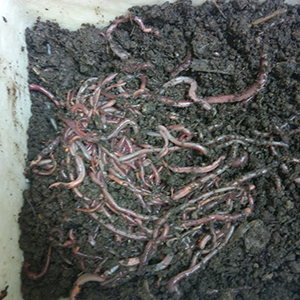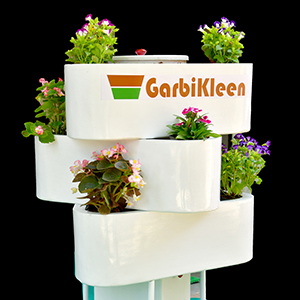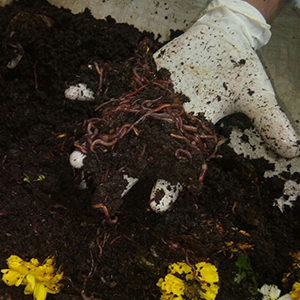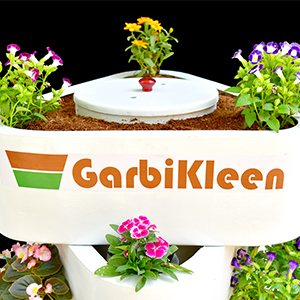Related Links
Garbikleen
Garbikleen, the unique wet waste processing unit developed, works at the household level. It works on segregation discipline, independent of neighbouring residents and thereby radically limits the problems associated with segregation. The unit is compact, easy to handle wet garbage and kitchen waste, and processes it without automatically without daily intervention. The wet waste deposited in the central waste column is speedily converted to vermi-compost by the charged bio-media at the time of installation. The charged bio- media comprises a carefully developed culture and most pertinent species of earthworms. The bio media helps in rapid decomposition of the waste, and converts the waste into vermi-compost. The waste column has provisions for worms and compost to be easily transferred to the surrounding plants which get the compost for nutrition and growth, and the soil is kept aerated by the worms. It is an aerobic system and hence it does not generate odour and gases. It is safer and easier as vermi-compost is stable, soil-like material and can be readily removed, if required. The nature of the process prevents any risk of mosquito breeding. The unit configuration immensely enhances the home décor and overcomes the fundamental apprehension of users to use such garbage processing unit inside or adjacent to the homes. The unit can be used both indoor and outdoor, and offers flexibility to the user.
Brief Information::
Garbikleen uses natures bio- degradation system by providing a complete food chain it develops a self-regulating eco system that stabilises and adapts gradually to effectively handle wide variations. Garbikleen there by supplements the natural eco-system in which it is located.

The household waste comprises wet waste and dry waste. Wet waste is usually from the kitchen, and dry waste which includes plastic, paper, glass, or metal scrap. Dry Waste should be segregated from the wet waste before the wet waste is charged in the Garbikleen. Research shows that over a sustained period, the user inculcates the habit of proper and regular segregation. The wet waste deposited in the central waste column is converted to vermi-compost by the charged bio-media at the time of installation. The charged bio- media comprises a carefully developed culture and most pertinent species of earthworms. The bio media helps in rapid decomposition of the waste, and converts the waste into vermi-compost. The waste column has provisions for worms and compost to be easily transferred to the surrounding plants which get the compost for nutrition and growth, and the soil is kept aerated by the worms. It is an aerobic system and hence it does not generate odour and gases. It is Safer and easier as vermi-compost is stable, soil-like material and can be readily removed if required. The nature of the process prevents any risk of mosquito breeding.

The wet waste deposited in the central waste column is speedily converted to vermi-compost by the charged bio-media at the time of installation. The charged bio- media comprises a carefully developed culture and most pertinent species of earthworms. The compost generated is Safe and easy, being a stable compound and soil like material that can be handled easily and readily removed.

-
Effectively treats household wet and kitchen waste with minimum intervention Enhances the home décor and offers indoor/outdoor flexibility depending on home sizes and layout. Highly User friendly.
-
Compact with very small foot print.
-
Aerobic process prevents any foul odours associated with wet garbage, due to rapid decomposition and aerobic treatment.
-
No need of handling sludge as wet waste sludge is rapidly converted into vermi-compost.
-
No energy requirements as it is a passive Process.
-
Develops a self - regulating ecosystem that stabilizes and adapts gradually to effectively handle wide variations of use.
-
No risk of mosquito breeding.
-
Supports organic growth of potted plants in the unit.

It is necessary to avoid dumping of large portion of vegetables, fruits, raw coconuts or shell coconuts in the Garbikleen, for effective and faster action. If the food waste is not cut into smaller pieces before being charged in the Garbikleen, it will result in faster filling of central waste column and might lead to slow decomposition and eventually improper / non-functioning of the process. 50-100 gm of compost generated in the system, when mixed with daily wet waste enhances the efficiency of the process. Besides this, the surrounding potted plants in the Garbikleen should be adequately watered daily for their growth as well as maintaining sufficient moisture in the Garbikleen. Once Garbikleen central waste column is full up to the indication mark on the central waste column, the bottom part of the Garbikleen is drawn out to remove the compost. This will contain compost, bio media including earth worms (if any) and untreated waste (if any). The bio media (earthworms) and untreated wet waste, if any, are removed from the mixture and charged backed in to the central waste column for future use. The remaining compost can be used by the user for any suitable application. This process should be repeated every 2-3 month depending on the average wet waste charged in the Garbikleen. The company offers this service to the users at normal fees, if required.
